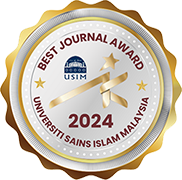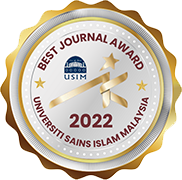CULTURED MEAT: AN APPRAISAL FROM THE FIQH AND SUFI VIEWS OF MUSLIM SCHOLARS
DOI:
https://doi.org/10.33102/mjsl.vol11no1.373Keywords:
Cultured meat, haram, halal, alteration of God’s creationAbstract
Meat comprises of important nutrients for human body. As population of human increases, the demand for meat also keeps increasing. Therefore, a new alternative is introduced by inventing a cultured meat obtained from the outer side of the animal's body and became the rumours in the 1930s. In spite of that, the idea of cultured meat invention was only realized in 2013 by a Dutch scientist which was invented a burger-shaped cultured beef. However, this invention did not exist in the time of the Prophet, his companions and the tābi'īn and it becomes a polemic among the Muslim community regarding of its halal status nowadays. The existence of cultured meat in the current society needs a clear explanation and procedure in fiqh because it is one of the new discoveries in food industry. This study is important as to provide a good understanding and new knowledge to the Muslim society. A clear fiqh approaches will give guidelines to the society whether considering it as a staple or alternative diet. Otherwise, they may avoid to consume cultured meat product as a precaution from haram and uncertainty (shubhah) and also may ensure of the purity of soul abreast with the main objective in sufism’s live. This study used qualitative descriptive research method by analyzing some previous studies as secondary sources that have been recorded elsewhere, processed, printed and disseminated to the public. The results found that cultured meat is a new discovery in Malaysia. Although the original law for this cultured meat is halal law, if it does not meet the shariah principles and criteria, it is considered haram. This review paper highlights on the halal status of cultured meat from fiqh and sufism in terms of the transformative form of Allah’s creation. Based on the primary sources of fiqh and sufism, the status of cultured meat is considered halal provided if in the condition of shortage of meat is affected the needs of population and also it causes no harm to people to consume as to enhance the prosperity of human beings. Further research must also be done to verify that it is also tayyiban and fulfils the maqasid in Islamic nutrition and the effects of consumption to consumers.
Downloads
References
Al-Athqalānī, Aḥmad Alī ibn Ḥajar. (2001). Fatḥ al-bārī syarḥ Ṣaḥīḥ al-Bukhārī. Riyad: Maktabah al-Malik Fahd.
Al-Attas, S. M. N. (1963). Some aspects of Sufism as understood and practised among the Malays. Shirle Gordon, Ed. Singapore: Malaysian Sociological Research Institute Ltd.
Abū Ḥayyān, Muḥammad ibn Yūsuf. (1993). Tafsīr al-baḥr al-muḥīṭ. Beirut: Dār al-Kutub al-‘Ilmiyyah.
Al-Bukhārī, Abū 'Abd Allāh Muḥammad. (2001). Ṣaḥīḥ al-Bukhārī. Beirut: Dār Ṭūq al-Najah.
Adams, J. (2018). Meat and Islam: How vegetarians in Egypt navigate faith and contemporary food ethics (Master's thesis). Available from Harvard University ProQuest Dissertations Publishing Theses database. (Record No. 28275849).
Al-Duʻaylaj, Mubārak ibn Muḥammad. (2000). Al-Waḍ’u fī al-Hadīth. Riyad: Maktabah al-Malik Fahd al-Waṭāniyyah.
Al-Ghazalī, Abū Ḥamīd. (1995). Al-Ghazali on disciplining the soul and on breaking the two desires. (Trans. T. J. Winter.). Cambridge: The Islamic Texts Society
Al-Ghazalī, Abū Ḥamīd. (n.d). Iḥya’ ‘ulum al-dīn. Cairo: Dār Iḥya’ al-Kutub al-‘Arabiyyah ‘Isa al-Babi al-Halabi wa Shurakah.
Al-Jawziyyah, Ibn Qayyim. (2006). Badā’i al-tafsīr: Al-Jām’i limā fassarahu al-Imām Ibn Qayyim al-Jawziyyah. Al-Damam: Dar Ibn al-Jawzi.
Al-Qaraḍāwī, Yūsuf. (1980). Al-Halal wa al-haram fī al-Islām. Cairo: Maktabah Wahbah.
Al-Qurṭubī, Abū ‘Abd Allāh Muḥammad bin Aḥmad ibn Abī Bakar. (2006). Al-Jāmi‘ li aḥkām al-Qur’ān wa al-mubayyin limā taḍammana min al-Ḥadīth wa aḥkām al-Furqān. Beirut: Muassasah al-Risālah.Al-Razi,
Al-Qushayri, Abū Al-Qāsim. (2007). Al-Qushayri's epistle on Sufism : Al-Risala Al-qushayriyya fi 'ilm al-tasawwuf (The great books of Islamic civilization). Reading, UK: Garnet Publishing.
Al-Rāzī, Abū ‘Abd Allāh Muḥammad. (2012). Al-Tafsīr al-kabīr. Beirut: Dar al-Fikr.
Al-Ṣābūnī, Muḥammad ‘Alī. (1981). Ṣafwat al-tafāsīr. Beirut: Dar al-Quran al-Karim.
Al-Sha‘rāwī, Muḥammad Mutawallī. (1971). Tafsīr al-Sha‘rāwī. Cairo: Al-Azhar Islamic Research Academy General Department for Research, Writing & Translation.
Al-Shanqiṭī. Muḥammad al-Amīn. (2005). Aḍwā’ al-bayān fī idāh al-Qurān. Makkah al-Mukarramah: Dar ‘Alam al-Fawa’id.
Al-Sinhaji, Shihab al-Din Abi al-‘Abbas. (2001). Kitab al-furuq: Anwar al-buruq fi anwar al-furuq, Kaherah: Dar al-Salam.
Al-Suyūṭī, Jalāl al-Dīn ‘Abd al-Raḥman ibn Abī Bakar, al-. (2003). Al-Durr al-manthūr fī tafsīr bi al-ma’thūr. Beirut: Dar al-Fikr.
Al-Ṭabarī, Abū Jaʿfar Muḥammad ibn Jarīr. (1994). Jāmiʿ al-bayān ʿan taʾwīl āy al-Qurʾān. (Tafsīr al-Ṭabarī). Beirut: Muassasah al-Risālah.
Al-Tirmīdhī, Abū ʿĪsā’ Muḥammad ibn ʿĪsā’ al-Sulamī, al-. (1996). Al-Jām‘ al-Kabīr. Beirut: Dār al-Garb al-Islamī.
Ansari, M. A. H. (1986). Sufism and Shari’ah. Leicester: The Islamic Foundation.
Al-Zarkashī, Badr al-Dīn Muḥammad bin Bahadir bin ‘Abdullah. (1992). Al-Bahr al-muhīt fī uṣūl al-Fiqh. Kuwait: Dār al-Ṣafwah.
Ba‘labakī, M. (1993). Al-Mawarid: A modern ‘Arabīc-English dictionary. Beirut: Dār al-‘Ilm lī al-Malayin.
Baharom, N. (2002). Kamus Dewan. Kuala Lumpur: Dewan Bahasa dan Pustaka.
Bailey, P., Holowacz, T., & Lassar, A. (2001). The origin of skeletal muscle stem cells in the embryo and the adult. Current Opinion in Cell Biology, 13 (6), 679-689.
Benjaminson, M. A., Gilchriest, J. A., & Lorenz, M. (2002). In vitro edible muscle protein production system (MPPS): stage 1, fish. Acta Astronautica, 51(12), 879-89.
Bhat, Z. F., Kumar, S., & Fayaz, H. (2014). In vitro meat production: Challenges and benefits Over Conventional Meat Production. Journal of Integrative Agriculture, 14(2), 241–248.
Bhat, Z. F., Bhat, H., & Pathak, V. (2014). Prospects for in vitro cultured meat: A future harvest. In Principles of tissue engineering. (4th ed.). Lanza R, Langer R, Vacanti Joseph (ed). Elsevier, San Diego: CA, USA. pp 1663-1683.
Bhat, Z. F. & Bhat, H. (2011). Animal-free meat bio fabrication. American Journal of Food Technology, 48(2), 125-140.
Bhat, Z. F., Kumar, S., & Fayaz, H. (2015). In vitro meat production: Challenges and benets over conventional meat production. Journal of Integrative Agriculture, 14(2), 241–248. http://doi.org/10.1016/S2095-3119(14)60887-X
Bracke, M. B. M. (2009). Animal welfare in a global perspective. Netherlands: Wageningen University & Research.
Bryant, C. (2020). Culture, meat, and cultured meat, Journal of Animal Science, 98(8),1-7. doi:10.1093/jas/skaa172
Carel, A. (1937). The culture of whole organs: I. technique of the cultured of the thyroid gland. Journal of Experimental Medicine, 65(4), 515–526.
Celada, P., Bastida, S., & Muniz, S. F. J. (2016). To eat or not to eat meat. That is the question. Nutricion Hospitalaria, 33(1), 177-81.
Choudhury, D., Singh, S., Seah, J. S. H., Yeo, D. C. L., & Tan, L. P. (2016). Commercialization of plant-based meat alternatives. Trends in Plant Science, 25(11), 1055-1058. 10.1016/j.tplants.2020.08.006
DeFoliart, G. R. (1992). Insects as human food. Crop Protection, 11(5), 395–399.
Duque, P., Gomez, E., Diaz, E., Facal, N., Hidalgo, C., & Diez, C. (2003). Use of two replacements of serum during bovine embryo culture in vitro. Theriogenology, 59(3-4), 889-99.
Edelmen, P. D., McFarland, D. C., Mironov, V. A., & Matheny, J. G. (2005). Commentary: In Vitro-cultured meat production. Tissue Engineering, 11(5-6), 659-662. doi.org/10.1089/ten.2005.11.659
Eelen, V. (1999). Industrial scale production of meat from in-vitro cell cultures. Retrieved International Application Published Under the Paten Cooperation Treaty (PCT) from the World Intellectual Property Organization Bureau website: https://patents.google.com/patent/WO1999031222A1/en
Fadzli, S. D. N. M., Reza Adnan, M. R. A., Baharuddin, A. S., & Wan Harun, M. A. (2021). Produk makanan ubah suai genetik (GMF) dalam perspektif konsep halalan toyyiban berdasarkan penilaian maqasid hifz an nafs. Malaysian Journal Syariah and Law, 9 (1), 73-99. https://doi.org/10.33102/mjsl.vol9no1.284
Fakhry, M. (2000). Islamic philosophy, theology, and mysticism: A short introduction. (2nd ed.). London: Oneworld.
Fattah, I. A.H. (1993). Nasha’at al-falsafah al-sufiyyah wa tatawwaru-ha. Beirut: Dar al-Jil.
Food and Agriculture Organization (FAO). (2011). Livestock’s long shadows - Environmental issues and options. Retrieved from https://www.fao.org/3/a0701e/a0701e00.htm
Fuseini, A., Wotton, S. B., Knowles T. G., & Hadley, P. J. (2017). Halal meat fraud and safety issues in the UK: A review in the context of the European Union. Food Ethics, 1(2), 127-142. doi.org/10.1007/s41055-017-0009-1
Godfray, H. C., Aveyard, P., Garnett, T., Hall, J. W., Key, T. J., Lorimer, J., Pierrehumbert, R. T., Scarborough, P. Springmann, M., & Jeb, S. A. (2018). Meat consumption, health, and the environment. Science, 361 (6399). doi.10.1126/science.aam5324
Gould, S., & Friedman, L.F. (2016). These are the countries where people eat the most meat. Retrieved from the Insider US Market Closed Website: https://www.businessinsider.com/where-do-people-eat-the-most-meat-2016-10
Grigg, D. (1995). The nutritional transition in Western Europe. Journal of Historical Geography; 21 (3), 247-261.
Hamdan, M. N., & Ramli, M. A. (2019). Daging kultur: Konsep, sejarah dan hukum Islam. Kuala Lumpur: Institut Kefahaman Islam Malaysia (IKIM).
Heinz, G., & Hautzinger, P. (2007). Meat processing technology for small to medium scale producers. Bangkok: RAP Publication
Hetts, S., Estep, D., & Marder, A. (2008). Psychological well‐being in animals: Conceptual Issues, behavioral measures, and implication for dogs. Advances in Companion Animal Behaviour, 21(2), 369-87. doi: 10.1016/s0195-5616(91)50039-5.
Hoekstra, A. K. & Chapagain, A. K. (2007). Water food prints of nations: Water use by people as a function of their consumption pattern. Water Resources Management, 21, 35-48. doi.org/10.1007/s11269-006-9039-x
Ibn Abī Ḥātim, ‘Abd al-Raḥman Muḥammad. (1997). Tafsīr al-Qurān al-Aẓīm musnadan ‘an Rasūlillāh wa al-Ṣaḥabah wa al-Tabi’īn. Riyad: Maktabah Nizar Mustafa al-Baz.
Ibn ‘Aṭiyyah, Abū Muḥammad ‘Abd al-Haqq. (2001). Al-Muḥarrar al-wajīz fī tafsīr al-kitāb al-‘ajīz. Beirut: Dar al-Kutub al-‘Ilmiyah.
Ibn Kathīr, 'Imād al-Dīn Abū al-Fidā’ Ismā’īl. (2000). Tafsīr al-Qur’ān al-‘Aẓīm. Cairo: Muassasah Qarṭabah.
Ibn Taymiyyah, Taqiyy al-Dīn Aḥmad al-Harranī. (2005). Majmu‘ al-fatāwā Shaykh al-Islām Aḥmad ibn Taymiyyah. Mansurah: Dar al-Wafa.
Ikhsan, M. (2018). Sejarah Mazhab Fikih di Asia Tenggara. Nukhbatul ‘ulum: Jurnal bidang kajian Islam, 4(2), 120-134.
Ismail, I., Hwang, Y. H., & Joo, S. T. (2020). Meat analog as future food: A Review. Journal of Animal Science and Technology, 62, 111-120.
Jabatan Kemajuan Islam Malaysia (JAKIM). (2011). Hukum memakan makanan terubahsuai genetik (Genetic modified food). Retrieved from: http://e-smaf.islam.gov.my/e-smaf/index.php/main/mainv1/fatwa/pr/10278.
Jochem, C., Valk, J., Stafleu, F., & Baumans, V. (2002). The use of fetal bovine serum: Ethical or scientific problem?. Alternatives to laboratory animals: ATLA, 30(2), 219-27.
Kelland, K. (2013). First taste of test-tube burger declared “close to meat”. Retrieved from the Reuters website: https://www.reuters.com/article/science-meat-in-vitro-idINDEE9740CY20130805
Knysh, A. (2000). Islamic mysticism: A short history. Leiden, Boston, Koln: Brill.
Knysh, A. (2017). Sufism: A new history of Islamic mysticism. Princeton & Oxford: Princeton University Press.
Larsson, S. C., & Wolk, A. (2006). Meat consumption and risk of colorectal cancer: A meta-analysis of prospective studies. International Journal of Cancer, 119(11), 2657–2664.
Mahato, S. (2019). Relationship of sanitation parameters with microbial diversity and load in raw meat from the outlets of the Metropolitan City Biratnagar, Nepal. Hindawi International Journal of Microbiology, 17. doi.org/10.1155/2019/3547072
May, A. S. G. (2013). In vitro meat: protein for twelve billion? (Master Thesis of Science Communication, University of Otago, New Zealand Retrieved from http://hdl.handle.net/10523/4101
Muslim, Muslim ibn al-Ḥajjāj. (2006). Ṣaḥīḥ Muslim. Riyaḍ: Dar Tayyiba lil-Nashr wa al-Tawzī’.
Nid, L., Pisestyani, H., & Basri, C. (2020). Studi kasus: Pemalsuan daging sapi dengan daging babi hutan di Kota Bogor. Jurnal Kajian Veterinar, 8 (2), 121-130.
Paul, A., Frederich, M., Uyttenbroeck, R., Hatt, S., Malik, P., Lebecque, S., Hamaidia, M., Miazek, K., Goffin, D., Willems, L., Deleu, M., Fauconnier, M. L., Richel, A., Pauw, E., Blecker, C., Monty, A., Francis, F., Haubruge, E., and Danthine, S. (2016). Grasshoppers as a food source? A review. Biotechnology, Agronomy and Society and Environment 20(S1), 337-352.
Paulsen, P., Nauman, K., Bauer, F., Avagnina, A., & Smulders, F. J. M. (2017). Game meat fermented products food sfety aspects. In N. Zdolec (Eds.), Food Biology Series Fermented Meat Products: Health Aspects (pp.58-77). Boca Raton: CRC Press Taylor&Francis.
Petriani, P., Hafid, H., Mirwanhono, R. E., and Wahyuni, T. H. (2020). Teknologi pengolahan daging. Medan: CV Anugerah Pangeran Jaya Press.
Pew Research Center. (2015). The future of world religions: Population growth projections, 2010-2050. Why Muslims are rising fastest and the unaffiliated are shrinking as a share of the World’s Population. Retrieved from https://www.pewresearch.org/religion/2015/04/02/religious-projections-2010-2050/
Post, M. J. (2012). Cultured meat from stem cells: challenges and prospects. Meat Science, 92(3), 297–301.
Post, M. J. (2014). Cultured beef: medical technology to produce food. Journal of the Science of Food and Agriculture, 94(6), 1039–1041. /doi.org/10.1002/jsfa.6474.
Seidel, K. (2000). Serving the guest: A Sufi cookbook. Retrieved from the Sufism and Vegetarianism website: https://www.superluminal.com/cookbook/essay_vegetarianism.html
Reese, J. (2018). The end of animal farming: How scientists, entrepreneurs, and activists are building an animal-free food system. Boston: Beacon Press.
Sans, P., & Combris, P. (2015). World meat consumption patterns: An overview of the last fifty years (1961–2011). Meat Science, 109, 106-111.
Schneider, Z. (2013). In vitro meat: Space travel, cannibalism, and federal regulation. Retrieved February 19, 2023, from https://houstonlawreview.org/article/4067-in-vitro-meat-space-travel-cannibalism-and-federal-regulation
Sealea, P., & Rudnicki, M. A. (2000). A new look at the origin, function, and “stem-cell” status of muscle satellite cells. Developmental Biology 218 (2),115-124.
Shah, G. (1999). Why do we still use serum in the production of biopharmaceuticals?. Developments in Biological Standardization, 99, 17-22.
Shindell, D., Faluvegi, g., Koch, D., Schmidt, G., Unger, N., & Bauer, S. (2009). Improved attribution of climate forcing to emissions. Science, 326, 716-718.
Smith, F. E. (1930). The World in 2030 A.D. London: Hodder and Stoughton.
Specter, M. (2011). "Test-tube Burgers." The New Yorker Magazine. Retrieved from the Burgers From A Lab: The World Of In Vitro Meat website: https://www.npr.org/2011/05/18/136402034/burgers-from-a-lab-the-world-of-in-vitro-meat
The National Aeronautics and Space Administration (NASA). (1998). An in itro edible muscle protein production system in small busines innovation research. Retrieved from https://sbir.gsfc.nasa.gov/SBIR/abstracts/98/sbir/phase1/SBIR-98-1-09.05-6812.html
United Nation. (2019). World population to reach 9.7 billion by 2050 new study predicts. Retrieved from https://www.un.org/en/development/desa/news/population/2015-report.html
Wahab, N. A., Shahwahid, F. M., Hamid, N. A. A., Othman, N., Ager, S. N. S., Abdullah, M., Miskam, S., & Saidpudin, W. (2016). Contributions of Malaysia and Singapore in the development of Halal industry in the ASEAN region. Asian Journal of Social Sciences & Humanities, 5(2), 37-46.
Weiss, F., & Leip, A. (2013). Greenhouse gas emissions from the EU livestock sector: A life cycle assessment carried out with the CAPRI model. Agriculture, Ecosystems and Environment, 149, 124-134.
World Population. (2020). Current world population. Retrieved February 19, 2023, from https://www.worldometers.info/world-population/
Wyers, R. (2019). The finishing touch for cultured meat? Spanish start-up scores in fat replication. Retrieved February 19, 2023, from https://gfi.org/wp-content/uploads/2021/01/INN-CM-SOTIR-2020-0512.pdf
Yanke, G. (2011). The path to the bloodless butcher: In vitro meat and its moral implications. The Triple Helix, Inc, 1, 8-9.
Zaraska, M. (2013). Lab-grown beef taste test: ‘Almost’ like a burger. Retrieved from the Washington Post website: https://www.washingtonpost.com/national/health-science/lab-grown-beef-taste-test-almost-like-a-burger/2013/08/05/921a5996-fdf4-11e2-96a8-d3b921c0924a_story.html
Downloads
Published
Issue
Section
License
Copyright (c) 2023 Iswandi Harahap Burhanuddin, Abdul Salam Muhamad Shukri, Mohd Bakri Abu Bakar, Mualimin Mochammad Sahid, Abdul Rahman Adam

This work is licensed under a Creative Commons Attribution-NonCommercial 4.0 International License.














































